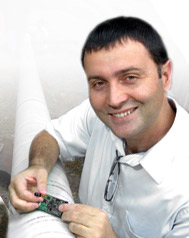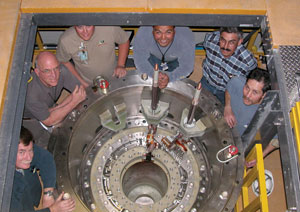About LANL
About Our Capabilities, Facilities, and Staff
"Los Alamos National Laboratory plays an indispensable role in building America as a science and technology powerhouse, and our staff are an incredible resource to the nation and the world." Michael Anastasio, Dir.
Solving Complex R&D Problems with Special Blend of Staff, Capabilities and Facilities
Now in its seventh decade, LANL remains among a very few laboratories that can bring great breadth of fundamental and discovery science, technology, and engineering rapidly together to create tangible solutions for national security needs.
Our staff, working with partners throughout science and industry, must be able to deliver today's solutions while maintaining the depth of capabilities to deliver the next generation of discoveries.
Los Alamos has demonstrated a cycle of innovation where we have developed world-leading capabilities and facilities in response to urgent, unique missions. We also spin out new discoveries that lead to emerging missions.
Being able to integrate and apply our capabilities rapidly to new challenges will be a key advantage in an increasingly competitive landscape.
Our Science, Technology and Engineering Priorities
Science that Matters
- Information science and technology enabling integrative and predictive science
- Experimental science focused on materials for the future
- Fundamental forensic science for nuclear, biological, and chemical threats
How We Work
- Collaborate, partner and team to make decisive contributions to our sponsors
- Outstanding operational excellence for safety, security, and efficient pursuit of ST&E for our missions
Transform Our Scientific Campus
- Campus for 2020 (consistent with complex transformation)
- Modern science facilities: LANSCE refurbishment, CMR replacement, Science Complex
- Signature facilities for experimental science (MaRIE) and computational science (Roadrunner)
More About This Science
The National High Magnetic Field Laboratory
The National High Magnetic Field Laboratory (NHMFL) is a general user facility open to all researchers, on a proposal review basis, who wish to perform experiments in high magnetic fields. There is typically no charge for the high magnetic fields, except in the case of proprietary research for which cost recovery would be required. The great majority of experimental research conducted at the NHMFL is in the fields of materials science and condensed matter physics. Pulsed magnets allow the researcher to reach higher magnetic fields than are possible with direct-current (DC) magnets.

The Pulsed Field Facility at Los Alamos National Laboratory in Los Alamos, New Mexico, is one of three campuses of the NHMFL. The other two labs are at Florida State University, Tallahassee (continuous fields, magnetic resonance, and general headquarters) and the University of Florida, Gainesville (ultra-low temperatures at high magnetic fields). The NHMFL is sponsored primarily by the National Science Foundation, Division of Materials Research, with additional support from the State of Florida and the US Department of Energy.
Los Alamos provides unique resources to the Pulsed Magnetic Field Laboratory of the NHMFL in the form of a 1.4 GVA inertial storage motor-generator for high field pulsed magnets. In addition to the 60 Tesla Long Pulse Magnet powered by the motor-generator, the NHMFL features capacitor-driven pulsed magnets.
The NHMFL supports a user facility open to all qualified users, develops magnet technology in association with the private sector, and advances sciences and technology opportunities using high magnetic fields.
Read about interesting science discovery based on research done at NHMFL: Scientists have discovered an ideal candidate for Bose-Einstein condensation in the ancient Chinese pigment, Han Purple.
Take a virtual tour of the NHMFL at Los Alamos at http://www.lanl.gov/orgs/mpa/ nhmfl /users/tour/welcome.html
Read more about the Laboratory's NHMFL program at http://www.lanl.gov/orgs/ mpa/nhmfl/.
Contact: MPA-NHMFL Group Leader Alex Lacerda, 505-665-6504.
World's Most Powerful Magnet
Holds answer to many new technology products

Quick read
A world-record-breaking magnet is helping scientists create next-generation materials that will help make our buildings greener, our gadgets smaller, and our power and light systems more efficient.
Scientists use strong magnetic fields to investigate inner workings of new, often-exotic materials. Los Alamos' Magnet Lab—creator of the world's most powerful magnet—is playing an important role in creating the materials of tomorrow.
Computers, cell phones, and iPods work largely because scientists were able to first understand and then control the electrons in silicon. The high-temperature superconducting materials known as cuprates could also have a great effect on society, except that a fundamental understanding of how their electrons behave is still lacking—until now.
With the flick of a few computer-controlled switches, a giant pulse of electricity races through the powerful electromagnet at the Los Alamos Pulsed Field Facility (i.e., the Magnet Lab). An immense magnetic field builds within the magnet's center, a field more than a million times stronger than Earth's, with the stored-energy equivalent of a few sticks of dynamite.
The magnet provides knowledge for a broad range of materials, including conducting metals, stringy polymers, and heat-resistant ceramics.
In many of the metals brought to the Magnet Lab, their free electrons behave strangely. In some, the electrons act as if they were obese particles with masses hundreds of times greater than those of normal electrons. In others, the free electrons, which normally avoid each other, cluster at regular positions within the material, creating an unusual secondary lattice within the main one, a "charge-density wave."
Then there are superconductors. When these metals are cooled close to absolute zero temperature (–273ºC), the free electrons form "pairs," a special quantum state that allows both electrons to move through the lattice without resistance. As a result, electricity flows through a superconductor without energy loss.
In ordinary superconductors, the electron pairs break apart even before the temperature rises above a frigid –250ºC, and the metal becomes a normal conductor of electricity. That's not the case for the high-temperature superconductor being studied by a Los Alamos team including John Singleton, Neil Harrison, Chuck Mielke, Fedor Balakirev, and Ross McDonald. The superconductor's electrons remain paired for another 60 degrees or so. And researchers can't agree on why.
The scientists who study heavy-electron behavior, charge-density waves, or high-temperature superconductivity know that an understanding of the arcane electron behaviors in those metals will give scientists a greater chance of creating the next-generation materials that will make our buildings greener, our gadgets smaller, our power and light systems more efficient.
Recently, some Magnet Lab staff took a major step toward deciphering the electron behavior in a high-temperature superconductor by measuring a distinctive and telling feature of the metal—its so-called Fermi surface. Such a measurement had eluded scientists for more than 20 years but was achieved using a cutting-edge measurement technique and the Lab's powerful new magnet, the 100-tesla multi-shot.
Some of the highest-pulsed magnetic fields on the planet are created at the Los Alamos Magnet Lab.
The Magnet Lab's generator, the largest in the world, can supply second-long pulses of electricity to power the large magnets.
A large coil may have hundreds of turns, and the thousands of amperes needed to produce 25 teslas generate enough heat (in a resistive, nonsuperconducting magnet) to melt the coil windings. That same field exerts a pressure on a piece of reinforcing steel that is more than twice what's felt at the bottom of the ocean. Designing an electromagnet that can survive a multi-tesla field and be used over and over again is remarkably hard.
"Every high-field magnet will eventually break down because we push the limits of what the materials can withstand," says Chuck Swenson, leader of the Pulsed Magnet Design project. "The challenge in producing ever-higher fields is to understand electromagnets well enough to create new, durable designs."
More than a decade of research has culminated in the Magnet Lab's 100-tesla multi-shot, currently the most powerful reusable magnet in the world. Designed to operate at 100 teslas, the multi-shot has so far been kept to 89.9 teslas, still a world record.
New Frontiers
The Los Alamos team is currently investigating how the Fermi surface evolves as the cuprate's composition changes. The Magnet Lab is continuing its quest to produce higher fields.

Ayyorgun breeds wireless nodes
Self-organizing sensor network research wins award
Wireless sensor networks soon may allow engineers to wirelessly monitor miles of gas and oil pipelines, rescue workers to detect signs of life under rubble, and monitor illicit trafficking and intrusions on international borders . . .
Currents, the Laboratory's monthly employee magazine, highlighting people in the workplace.








